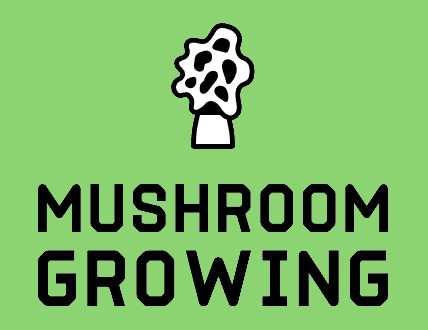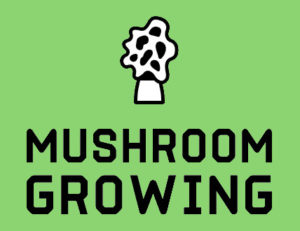Oyster mushrooms are popular edible fungi characterized by their thin and fan-like fruitbody. They have a mild taste, hence their name.
The oyster mushroom is the most common edible mushroom to grow, according to traditional Chinese medicine.
They are rich in nutrients and have several health benefits, including boosting the immune system, lowering cholesterol levels, promoting digestive health, relieving constipation, and more.
Oyster mushrooms are available fresh or dried at any Asian grocery store. They are also available canned at some supermarkets.
The top 5 oysters mushrooms to grow at home are:
1. Blue Oyster Mushrooms (Pleurotus ostreatus)
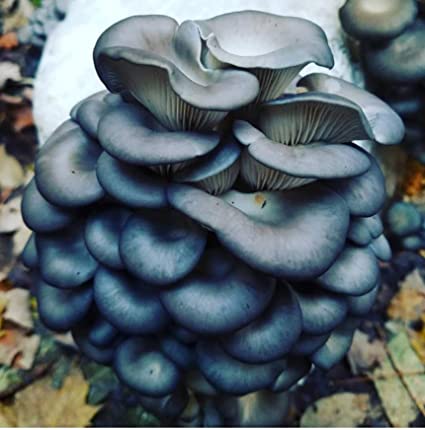
What Is The Blue Oyster Mushroom?
The blue oyster mushroom is a type of edible mushroom belonging to the Pleurotus genus. It is native to Asia, Australia, and southern Europe.
In Asia, it has been cultivated for more than 400 years. Traditional Chinese medicine practitioners use blue oyster mushrooms to treat asthma symptoms and pulmonary tuberculosis, as well as other respiratory conditions.
The blue oyster mushroom is a popular ingredient in French and Italian cuisines, due to its mild taste. It has a firm texture and can be used as an alternative to meat or seafood for vegetarians.
Health Benefits Of The Blue Oyster Mushroom
The blue oyster mushroom is rich in nutrients, making it ideal for good health. Some of the nutrients found in blue oyster mushrooms include niacin, riboflavin, selenium, calcium, vitamin C, and folate.
Blue oyster mushrooms contain potassium which helps lower blood pressure. They are also high in antioxidants that promote heart health.
The dietary fiber found in blue oyster mushrooms is good for digestive health. The chromium present helps balance blood sugar levels and improve insulin resistance, making it suitable for the treatment of type 2 diabetes.
They have anti-inflammatory properties which can help reduce pain associated with arthritis and rheumatism. They may also help prevent joint and bone deterioration.
Consuming blue oyster mushrooms may lead to a reduction in LDL cholesterol levels thanks to their phytosterol content. Phytosterols have been found to prevent the formation of intestinal ulcers, making them beneficial for digestive health.
Ideal Conditions To Grow Blue Oyster Mushrooms
Blue oyster mushrooms grow best in humid environments with plenty of rainfall. They are best grown on logs made of hardwood like oak, beech, and maple.
They can also be grown on a wide variety of substrates: cottonseed hulls, sawdust, or straw-based substrates. Blue Oysters mushrooms require fresh air flow, hence growing them in an enclosed environment is not recommended.
The optimal temperature for blue oyster mushroom cultivation is between 15 and 30 degrees Celsius.
It takes about a month for blue oyster mushrooms to mature. They are ready to be harvested when the underside of their caps turns light brown and starts opening up like fans.
How To Grow Blue Oyster Mushrooms
Blue oyster mushrooms are relatively easy to grow. The following steps will get you started growing them at home:
1. Prepare your log or substrate by soaking it in water overnight first.
2. Drill holes into the log, spaced about 2 inches apart. Place a piece of cotton wool soaked with mushroom spore solution into each hole.
3. Cover the log or substrate with a plastic sheet and place it in a warm, humid, and dark location until the mushrooms begin to grow (about 1 month).
5. Harvest time: when about half of the underside of their caps turn light brown and start opening up like fans, they are ready to be harvested. Do not wait for the whole cap to turn brown as this is an indication that they are old and may be harmful to your health if consumed.
4. Once harvested, store the mushrooms in dried or dehydrated form by hanging them upside down in a cool dry place with good ventilation. They can stay fresh for up to 1 year when stored properly.
2. King Oyster Mushrooms (Pleurotus eryngii)
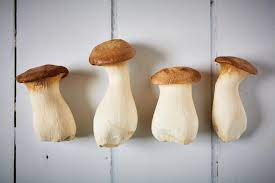
What Is King Oyster Mushroom?
King oyster mushrooms are also known as king trumpet or king fungus. They are a type of Pleurotus mushroom belonging to the oyster mushroom family. Like other Oyster mushrooms, they have fan-like fruitbodies with a mild taste.
King oysters grow wild across Asia, however, they are increasingly cultivated for commercial purposes in countries like China, Thailand, and Vietnam.
King oysters are sold in Asian wet markets in fresh or dried forms. Dried king oyster mushrooms can be rehydrated when cooking soups, while fresh ones can be used to make savory dishes.
Health Benefits Of The King Oyster Mushroom
They are rich in protein (about 20-25g per 100g), fat, carbohydrate, and dietary fiber. They also have high levels of calcium, niacin, selenium, potassium, and iron.
King oysters contain polysaccharide compounds that boost the immune system to fight off infections. They also contain lentinan and polysaccharide K, which have antitumor and immune-stimulating properties.
They contain Vitamin D, which is hard to source from other foods that can be eaten on a daily basis. Foods rich in Vitamin D help build strong bones and teeth, as well as increase calcium absorption from food consumed.
Ideal Conditions To Grow King Oyster Mushrooms
King oysters are grown on a wide variety of substrate materials, including pasteurized straw, cottonseed hulls, and wood chips. When growing them at home, however, it is recommended that you use a mixture of rye bran and sawdust as substrate material.
The optimal temperature for king oyster mushroom cultivation is between 20 and 30 degrees Celsius with high humidity. The substrate needs to be moist enough to encourage the growth of mycelium, but not too moist as this can cause other fungal spores to grow on it.
King oyster mushrooms take about a month to grow before they are ready to be harvested. They are ready when the underside of their caps turns light brown and starts opening up like fans.
How To Grow King Oyster Mushrooms
1. Prepare the substrate mixture by mixing sawdust and rye bran in a 5:1 ratio. Place this mixture in buckets or trays and fill each bucket with 1 inch of the substrate to allow for easy cultivation.
2. Drill holes into the substrate, spaced about 2 inches apart. Place a piece of cotton wool soaked with mushroom spore solution into each hole.
3. Cover the substrate with a plastic sheet and place it in a warm, humid location until the mushrooms begin to grow (about 1 month). It is important to keep the humidity at 80-90% for king oyster mushroom cultivation. The plastic sheets should also be changed every 2-3 days to maintain high humidity levels.
4. Harvest time: when about half of the underside of their caps turn light brown and start opening up like fans, they are ready to be harvested. Do not wait for the whole cap to turn brown as this is an indication that they are old and may be harmful to your health if consumed.
5. Once harvested, store the mushrooms in dried or dehydrated form by hanging them upside down in a cool dry place with good ventilation. They can stay fresh for up to 1 year when stored properly.
3. Nile Oysters mushrooms (pleurotus nebrodensis)
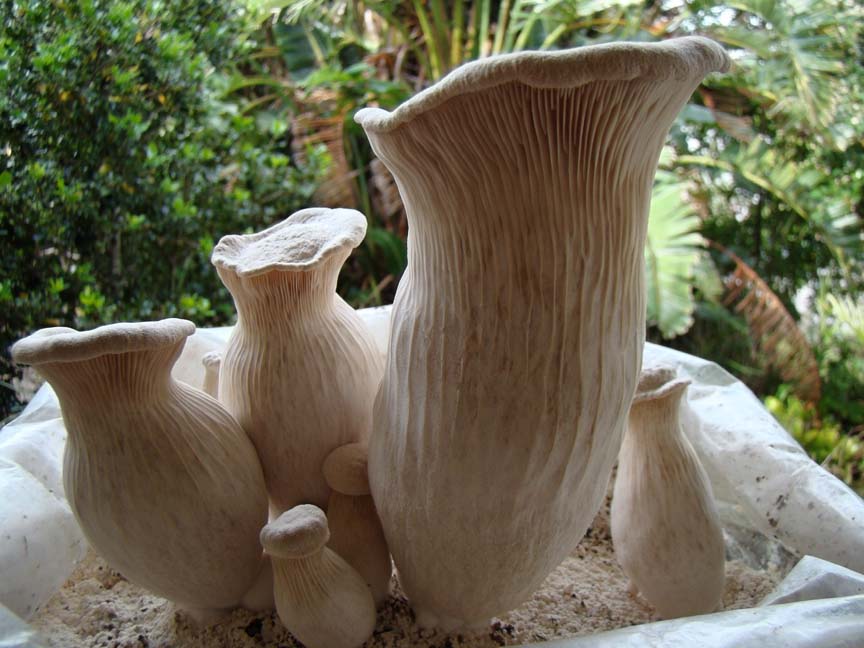
What Is The Nile Oyster Mushroom?
Nile oyster mushrooms are a type of Pleurotus mushroom that belong to the Oyster mushroom family. They were first reported in the early 19th century by Italian botanist Giuseppe Inzenga, who named them "Pleurotus nebrodensis" after the city of Nebrodi Mountains in Sicily.
They are native to Southeast Asia but have since been introduced into other tropical regions like South America, Central America, Mexico, and Africa. Like other Oyster mushrooms, they have fan-like fruitbodies with a mild taste.
Health Benefits Of Nile Oyster Mushrooms
Nile Oysters contain 16g of protein (per 100g), fats, carbohydrates, and dietary fiber. They are rich in potassium (about 400mg per 100g) and iron (approximately 4.7mg per 100g). They also contain significant quantities of selenium ( about 20μg/100g), calcium (20-30mg/100g), Vitamin C, thiamin, riboflavin, niacin, and carotene.
Nile Oyster mushrooms have been found to have anti-cancer properties. In a study conducted by researchers from the Chinese University of Hong Kong, oyster mushrooms were able to inhibit the proliferation of human cancer cells and blood vessel formation in a process called angiogenesis.
They also contain several healthful compounds that can stimulate the immune system including ergosterol, lanosterol, and vitamin D2 (ergocalciferol).
Ideal Conditions To Grow Oyster Mushrooms
Nile Oysters thrive in warm, moist, and humid environments. They require a temperature between 18-25 degrees Celsius with high humidity (above 90%).
They can be cultivated on a variety of substrates such as wheat bran, cottonseed hulls and sawdust.
They prefer light, loose soils with good aeration and drainage that allow for easy mushroom formation.
How To Grow Nile Oyster Mushrooms
1. Prepare the substrate mixture by mixing sawdust or cottonseed hulls with wheat bran in a ratio of 2:1. Soak the substrate mixture in water for 24 hours to allow it to expand. Drain out excess water before use.
2. Cut sections of mature mushroom into bite-sized chunks and place them on top of the substrate, spacing them about 1 inch apart.
3. Incubate the substrate for about a month until mushroom formation begins to appear. Ensure that the humidity levels are maintained at 80-90% while incubating oyster mushrooms on substrate blocks. The plastic sheets should also be changed every 2-3 days to maintain high humidity levels.
4. Harvest time: when light brown in colour with pronounced fan-like gills and 1 inch in diameter. Harvest the mushrooms by cutting them off with a sharp knife. Store them in dried or dehydrated form by hanging them upside down in a cool dry place with good ventilation until required for use.
4. Pink Oyster Mushroom(Pleurotus djamor)
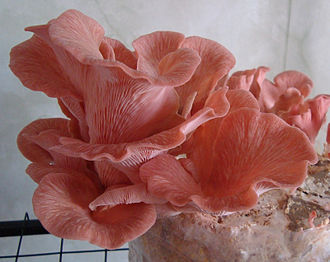
What is the Pink Oyster Mushroom?
The pink oyster mushroom (Pleurotus djamor), is a type of edible mushroom belonging to the Oyster mushroom family. It was first discovered in Ghana and introduced into many other tropical regions like South America, Central America, Mexico, and Africa. It is popularly known as 'pink oyster' to differentiate it from the other Pleurotus species.
They are native to Southeast Asia but have since been introduced into other tropical regions like South America, Central America, Mexico, and Africa. Like other Oyster mushrooms, they have fan-like fruitbodies with a mild taste and a slight pink tone at the margin of the cap.
Health Benefits Of Pink Oyster Mushrooms
Like other oyster mushrooms, the pink oysters contain 16g of protein (per 100g), fats, carbohydrates, and dietary fiber. They are rich in potassium (about 400mg per 100g) and iron (approximately 4.7mg per 100g). Like other oysters, they also contain significant quantities of selenium,( about 20μg/100g), calcium,(20-30mg/100g), Vitamin C, thiamin, riboflavin, niacin, and carotene.
The pink oyster mushroom is a medicinal mushroom with antioxidant properties that can also be used as an immune system booster and also effective in preventing atherosclerosis (a condition in which the arteries become clogged due to fat deposits).
Pleurotin present in pink oyster mushrooms has also been shown to have a preventive effect against breast cancer, prostate cancer, and lung tumors in laboratory studies.
Ideal Conditions To Grow Pink Oyster Mushrooms
They require a temperature between 18-25 degrees Celsius with high humidity.
Ideal levels of humidity are between 80-90%.
They prefer light, loose soils with good aeration and drainage that allow for easy mushroom formation. The substrate should be well-drained so it does not accumulate excess water.
How To Grow Pink Oyster Mushrooms
1. Prepare the substrate mixture by mixing sawdust or cottonseed hulls with wheat bran in a ratio of 2:1. Soak the substrate mixture in water for 24 hours to allow it to expand. Drain out excess water before use.
2. Cut sections of mature mushroom into bite-sized chunks and place them on top of the substrate, spacing them about 1 inch apart.
3. Incubate the substrate for about a month until mushroom formation begins to appear. Ensure that the humidity levels are maintained at 80-90% while incubating oyster mushrooms on substrate blocks.
The plastic sheets should also be changed every 2-3 days to maintain high humidity levels.
4. Harvest time: when light brown in color with pronounced fan-like gills and 1 inch in diameter. Harvest the mushrooms by cutting them off with a sharp knife. Store them in dried or dehydrated form by hanging them upside down in a cool dry place with good ventilation until required for use.
5. Golden Oyster Mushrooms(Pleurotus citrinopileatus)
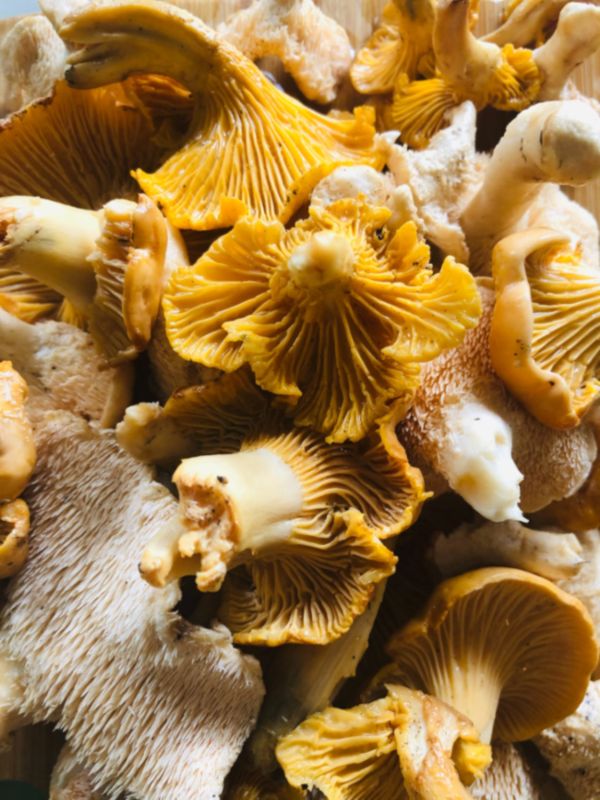
What Is The Golden Oyster Mushroom?
The golden oyster mushroom (Pleurotus citrinopileatus), is also known as the yellow oyster mushrooms, are native to Southeast Asia but have since been introduced into other tropical regions like South America, Central America, Mexico, and Africa.
Like other Oyster mushrooms, they have fan-like fruitbodies with a mild taste and a slight yellow tone at the margin of the cap. They belong to the Pleurotus genus which is known for its medicinal properties.
Health Benefits Of Golden Oyster Mushrooms
As an adaptogen, it possesses anti-inflammatory and antioxidant properties that can help in preventing/fighting cancer and treating neurodegenerative diseases such as Alzheimer's Parkinson's diseases.
It is considered a powerful source of natural antioxidants such as ergothioneine and glutathione which can also help in the detoxification of the liver.
Additionally, it reduces cholesterol levels and prevents cardiac diseases by lowering total cholesterol, triglycerides, and LDL while increasing HDL.
Ideal Conditions To Grow Golden Oyster Mushrooms
The ideal temperature for fruiting of Pleurotus citrinopileatus is 22-24°C with high humidity (60-80%).
Light or bright indirect sunlight at room temperatures is recommended to allow for good fruitbody formation.
They require cultivation on wood logs, on stumps, or on waste sawdust/wood chips/branches from either broadleaf trees like willow or conifers like Douglas fir or pine.
How To Grow Golden Oyster Mushrooms
1) First, sterilize the substrate by placing it in a plastic bag with 5% bleach solution for 10 minutes. Remove the substrate from the bag and drain off any excess liquid after 10 minutes then allow it to dry at room temperature with good ventilation for about 24 hours before use
2) Prepare wood logs that are between 3-4 feet long by drilling holes of 1-inch diameter throughout the length of the log using an electric drill.
Space out holes at intervals of approximately 4 inches along the entire length. Fill each hole with prepared spawn using a fungal dowel (inoculation tool). Ensure that there is enough spawn material added to each hole. Punch holes in the ends of the logs with a hammer to allow for aeration
3) Seal the inoculated logs by plugging up all holes using wax or beeswax especially if they are placed outdoors exposed to open air so that insects do not contaminate the process
4) Incubate inoculated logs in humid areas at optimal conditions of 70-80 degrees F and humidity levels around 80% for 1 month. Ensure that there is good ventilation provided during this period to avoid any risk of contamination
5) Golden oyster mushrooms will start to appear in 2 weeks after incubation. Harvest time: once brown in color, golden-yellow gills indicate ideal harvest time. Cut them off with a sharp knife and store them in dried or dehydrated form by hanging them upside down in a cool dry place with good ventilation until required for use.
Conclusion
Oyster mushrooms are a great option for those looking to grow their own food. With this list of oyster mushroom varieties, you can choose the best one(s) for your needs and location.
They provide the perfect balance of nutrients and taste while being easy to grow in your own backyard or even indoors on a countertop.
If you're looking for an interesting way to get more healthy foods into your diet that's not only tasty but also sustainable, oyster mushrooms may be just what you need.
Have you ever tried oyster mushrooms before? Which of these 5 mushrooms would you like to try growing?
Share in the comments below!
